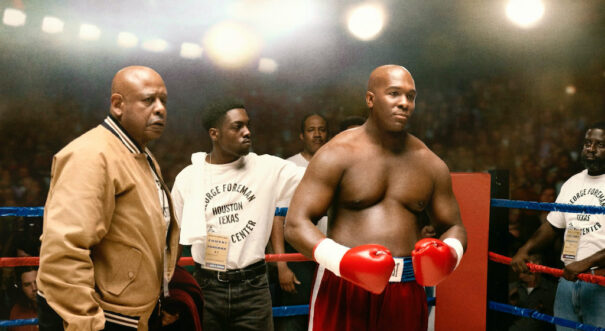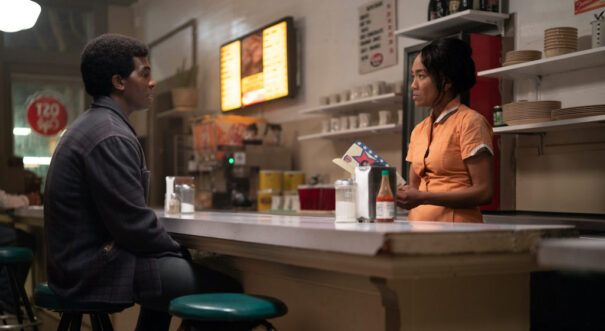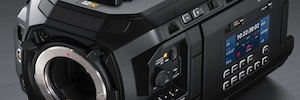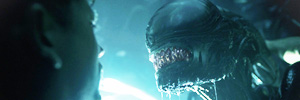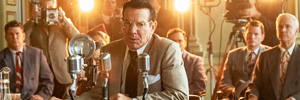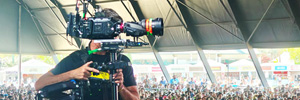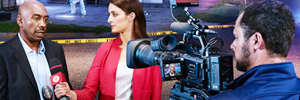Company 3 and SpinVFX use DaVinci Resolve Studio on the film ‘Big George Foreman’.
‘Big George Foreman’, directed by George Tillman Jr. used DaVinci Resolve Studio (Blackmagic Design) to create images of the spectators by SpinVFX and recreate the period setting by Company 3.
Toronto based visual effects (VFX) house SpinVFX helped create the ringside VFX for Foreman’s many pivotal boxing matches, starting in the 1960s and continuing through the 1990s when Foreman was crowned the oldest heavyweight champion in the world.
Led by VFX Supervisor Andrew McPhillips, the SpinVFX team helped create period appropriate VFX for each of Foreman’s notable boxing matches in the film. McPhillips explained, “Since the film is based on a true story, we were able to reference the actual crowds and rings from each of these matches. Everything began in preproduction with Director George Tillman Jr.’s detailed color script and ran through post with us using different looks and color palettes to tell the distinct story for each of the fights.”
The SpinVFX team worked on 10 fights for the film, with each having a distinct look inside and outside of the ring. For example, when creating cheering crowds for Foreman’s first fights in the 1960s, SpinVFX used more of a harmonious palette of browns and blues. Then, for The Rumble in the Jungle fight vs. Muhammad Ali in the mid 1970s, things became a bit more garish and colorful. Along with these looks reflecting the actual crowds and fashions of the time, they also mirrored Foreman’s emotions and life outside the ring to aid in the film’s storytelling.
“The costume department spent a lot of time getting things historically accurate and following the color script. We took photogrammetry scans of the crowd during production and used them as the base for our background shots, which we then keyed and brought into DaVinci Resolve Studio for the look development phase,” noted McPhillips.
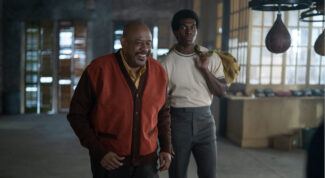 “DaVinci Resolve Studio really let us try out different looks and brainstorm the approach we wanted to take for each fight. Before we began designing the VFX lighting and backgrounds, we played around with different color stories that enhanced the work already done by the costume department and set design. We used Resolve to build themes for each of the crowd scenes,” McPhillips said. “With each fight having its own defined look for the VFX, we were able to play with the nuances of color within the historical palettes. Since the film is based on a true story, it was really cool to be able to look back at photos of the actual fights and build the story from there, whether it was emphasizing bright, happy colors for the Moorer fight in the 1990s or more of a monochrome look with occasional hits of bright yellow, blue and pastels for the gold medal Olympics fight vs. Čepulis in 1968.”
“DaVinci Resolve Studio really let us try out different looks and brainstorm the approach we wanted to take for each fight. Before we began designing the VFX lighting and backgrounds, we played around with different color stories that enhanced the work already done by the costume department and set design. We used Resolve to build themes for each of the crowd scenes,” McPhillips said. “With each fight having its own defined look for the VFX, we were able to play with the nuances of color within the historical palettes. Since the film is based on a true story, it was really cool to be able to look back at photos of the actual fights and build the story from there, whether it was emphasizing bright, happy colors for the Moorer fight in the 1990s or more of a monochrome look with occasional hits of bright yellow, blue and pastels for the gold medal Olympics fight vs. Čepulis in 1968.”
McPhillips noted that DaVinci Resolve Studio’s ease of use allowed them to quickly dive into things so they could focus on the creative and not get bogged down with the technical aspects. “DaVinci Resolve Studio was crucial during the concept phase. We used the color wheels to easily try out different palettes, which allowed us to flex our creative muscles,” he added. “While we wanted to have fun and test out different looks, we also needed to make sure we were laying the groundwork for the final VFX. Color consistency was key, and Resolve made that a breeze, since we had a MacBeth chart and could quickly use the built in color match tool to ensure tones were correctly graded throughout.”
“Creativity is at the heart of our VFX work, so having tools that allow us the freedom to explore different concepts without losing valuable time is a gamechanger,” McPhillips concluded. “Especially for a film like this where we wanted to have such distinct looks for each of Foreman’s boxing matches to help show the different years and phases of his life, that creative process was key. DaVinci Resolve Studio made the look development phase a breeze, and, more importantly, fun.”
Company 3
Senior Colorist Siggy Ferstl of Company 3 helped bring the true story to life by working with Tillman and Cinematographer John Matysiak to develop period looks that aided in distinguishing the different decades and fights of Foreman’s life, while balancing the overall story with a distinct, harmonious look that provided consistency throughout the film.
Ferstl’s tool of choice is DaVinci Resolve Studio. “We used Resolve’s magic mask for object isolation and tracking, which simplified the process of selecting individual characters and separating foregrounds and backgrounds for different types of corrections in the fight scenes,” said Ferstl.
“For some fights, we brought down the crowd ‘exposure’ in the grade to add contrast and break things up a bit, creating darker and lighter areas in the frame,” he continued. “We also used Resolve’s Open FX tools to add in little additional touches like lens reflection, flare and glow effects in some of the boxing matches to help integrate the foreground and background.”
Ferstl was able to help the filmmakers distinguish not only the different time periods but also the different locations of Foreman’s fights.
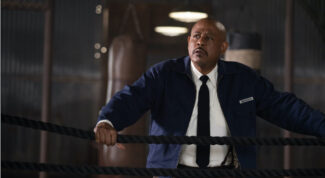 “Each fight is in a different location, so we gave each one a distinct look,” Ferstl explained. “He’s touring the world, fighting in Mexico, Zaire and Jamaica, so each boxing ring was different. We’d use what was shot and accentuate certain elements, always playing off the photography. For example, some rings were more of a powdery blue, while some others were a rich, deep blue and we enhanced those differences. We also adjusted the color temperature in different fights to emphasize different locations. Sometimes we’d have things look more tungsten color, other times we let the space have a clean daylight look and neutral blues.”
“Each fight is in a different location, so we gave each one a distinct look,” Ferstl explained. “He’s touring the world, fighting in Mexico, Zaire and Jamaica, so each boxing ring was different. We’d use what was shot and accentuate certain elements, always playing off the photography. For example, some rings were more of a powdery blue, while some others were a rich, deep blue and we enhanced those differences. We also adjusted the color temperature in different fights to emphasize different locations. Sometimes we’d have things look more tungsten color, other times we let the space have a clean daylight look and neutral blues.”
In the fight set in Las Vegas in the 1990s, he pointed out, “Everything is cleaner and brighter, and we didn’t add lens flares like we had for earlier fights. Then for a flashback sequence during a pivotal fight, we see scenes from throughout his life and we created an overall desaturated look and heavily vignetted the frame to give the flashback its own look.”
Additionally, Ferstl used Resolve’s grain toolset to add film grain on top of the digitally shot images, not so much to literally emulate film, but more to subtly enhance the imagery.
“We came up with a nice grain pattern for the film, which we varied throughout, adjusting for the look and texture. Resolve’s film grain tool comes with a lot of controls to manipulate the grain beyond just sizing, texture and strength; I could also control how pronounced it was on different color channels or different parts of the grayscale. It really came in handy and was effective when we wanted to add some texture to the image. For example, for an important scene inside a church, the actual location had very sparse walls, so by introducing a little more grain there, it just adds a very subtle amount of texture that we all liked.”
您喜欢这篇文章吗?
订阅我们的 饲料 而且你不会错过任何东西。



